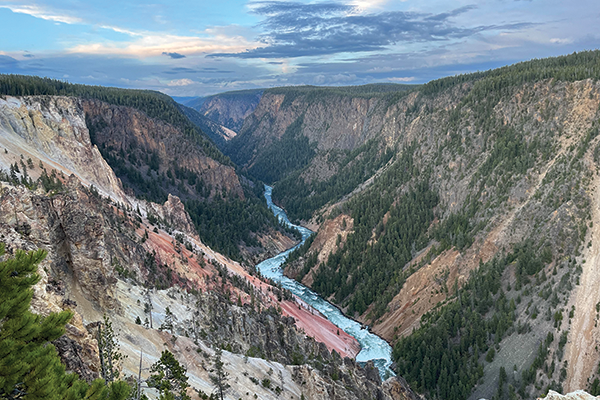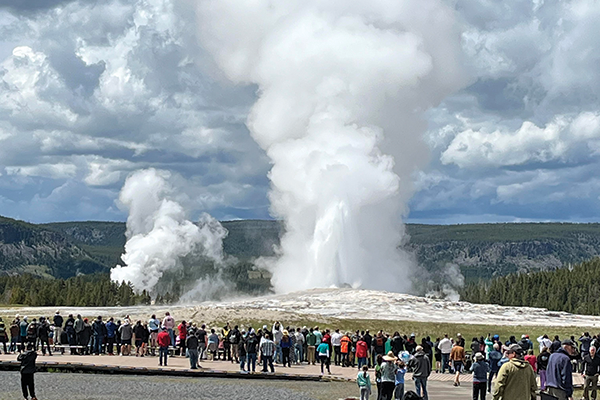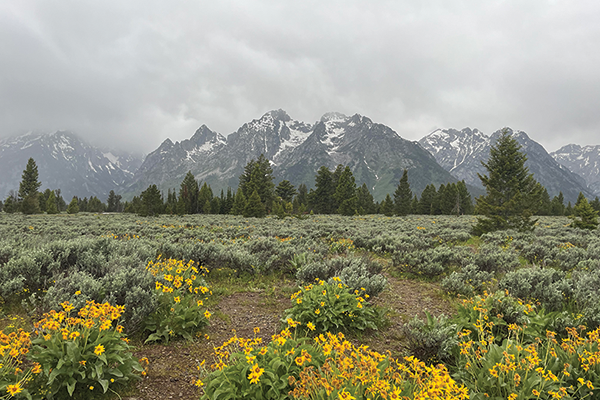Destination: Grand Tetons and Yellowstone National Park

Discover the breathtaking beauty of Grand Tetons and Yellowstone National Park, filled with stunning landscapes, majestic wildlife and unforgettable adventures. Photo: Kelli Wayne
Dreaming of your next vacation destination, but wondering where to begin? With the popularity of the Grand Tetons and Yellowstone National Park, planning is key, so let me take you through our adventure. We made lodging reservations early, nearly a year in advance. Park lodging fills up fast! There are many ways to stay in or near the parks depending on your budget and the sights you want to see.
Navigating these stunning parks is a breeze thanks to the drivable “loop” layout. To enhance our exploration, we downloaded the GuideAlong app. This convenient companion provides an immersive audio guide, narrating must-see stops and fascinating points of interest. No worries about weak Wi-Fi signals; this app utilizes your phone’s GPS chip and free satellite signal for seamless navigation.
We knew there would be a lot of driving in both parks, so we opted to fly into Salt Lake City and rent a car to take the approximately 5-hour drive toward the Grand Tetons. Arriving at Togwotee Mountain Lodge near the Moran Junction, it was a perfect location, situated at the northern entrance to the Grand Teton 42-mile loop. Our quaint cabin (hotel rooms are also available) had all the amenities to make this our base camp. There are two restaurants on-site.
The next day we set out on the loop drive, which can be done in 1 to 2 hours, depending on your stops. Hike one of the many trails or hop on the ferry at Jenny Lake, which arrives at the Hidden Falls trailhead (a moderate 4.9-mile hike).

The Grand Canyon of Yellowstone. Photo: Kelli Wayne
After two days of exploring this area, we drove about 50 miles north to the south entrance of Yellowstone. There are five entrance/exit points (north, east, south, west and northeast), and you can quickly begin your trip at any of them, depending on your location.
The breathtaking abundance of nature abounds upon entry to the park. Waterfalls, geysers, wildlife and sweeping views will greet you. We saw bison in almost every part of the park. Driving the loop up to Old Faithful is a must-see attraction for anyone visiting the park. Staying one night at the Old Faithful Inn, a national historic landmark built over 100 years ago, was a highlight of our trip. The following day, we continued north up the loop to the Norris Geyser Basin, one of the “hottest and oldest” of Yellowstone’s thermal areas.

Old Faithful. Photo: Kelli Wayne
Stops to make include: Excelsior Geyser, Turquoise Pool, Opal Pool, Flood Geyser, Spray Geyser and Imperial Geyser. The last two require a moderate hike behind the Grand Prismatic Spring, and all of these areas are mentioned in the GuideAlong app as we drove along. Wildlife (usually bison) often created traffic jams; however, park rangers were generally nearby, guiding traffic or speaking with curious bystanders. We then headed to Tower Junction (where we saw a black bear) and continued south to our accommodations at Canyon Lodge & Cabins in the east area of the loop. There are many places for food and grocery in Canyon Village, and we found it an excellent area to drive south and explore the Grand Canyon of Yellowstone, Mud Volcano, Hayden Valley and Lake Yellowstone. One of the best times to see the park was at dusk, well before sunset when crowds have dissipated and animals are out for their evening meal.
We learned as we drove to look for folks pulled over with spotting scopes, as they usually have zeroed in on wildlife scouring the area. One evening out, we saw a grizzly with two cubs (from a distance with binoculars), bison, elk, two baby bald eagles and antelope. The Grand Canyon of Yellowstone was stunning at dusk, and I was able to capture great pictures highlighting the waterfall. Our outing the next day was through the middle of the loop, which leads to the Norris Geyser Basin. There’s not much to see on the way, mostly just a thick forest of lodgepole pines. The drive is about 20 to 30 minutes.
On the last day we drove to the Lamar Valley in the northeast corner, a hot spot to see Yellowstone wildlife. It’s an expansive valley (approximately 29 miles long), and my research showed it as a likely area to spot the gray wolf; however, we weren’t so lucky this time. Approximately 120 to 130 wolves roam the park, so it is possible to see them; however, they are usually most active at dawn and dusk. Other animals we saw in the valley were coyotes, elk, antelope and bison. We continued toward the north exit of the park to our final stop at Mammoth Hot Springs. It takes a little over an hour to hike the main and lower terraces there, but you can also see quite a bit just from the parking area.

The Grand Tetons. Photo: Kelli Wayne
Yellowstone and the Grand Tetons were truly unforgettable destinations for me, and organizing my vacation was easy to do. I used Trip Advisor forums and Google to plan most of my trip, as you can enter and exit in many ways. Remember that services and roads are limited in the winter months, and summer brings out the vacationers and road repairs, so be prepared.
More information:
NPS.gov/GrandTetons
NPS.gov/Yellowstone
YellowstoneNationalParkLodges.com

